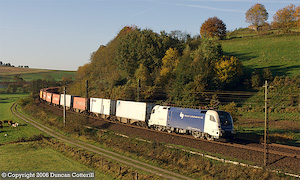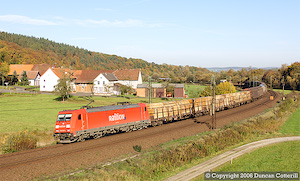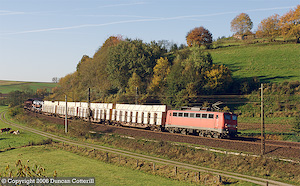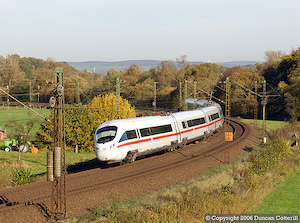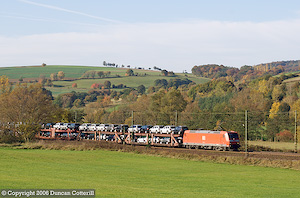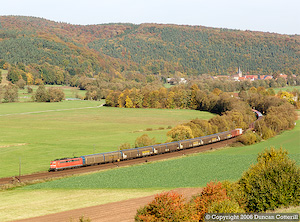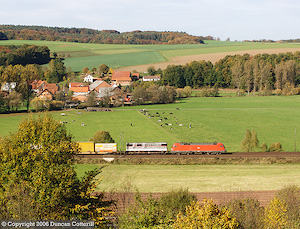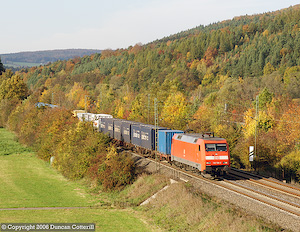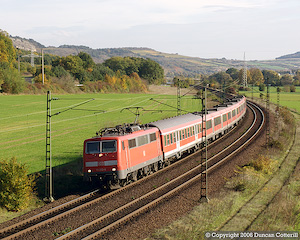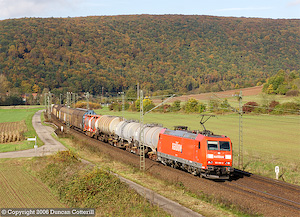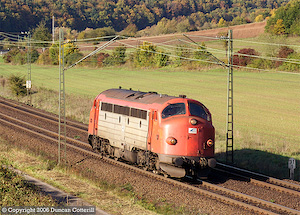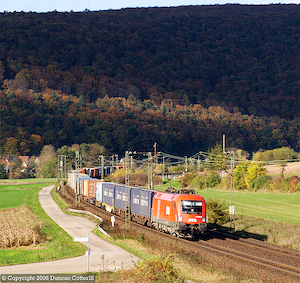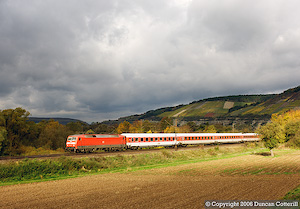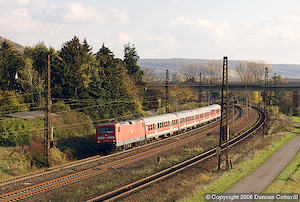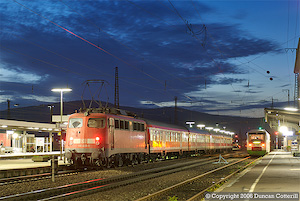Electric Freight Corridor
25 - 29 October 2006
Report by Duncan Cotterill
Introduction
This report details a photographic trip to one of the busiest electrified main lines in Germany. The railway north from Würzburg through Gemünden, Fulda and Bad Hersfeld to Bebra runs through hilly country close to the former East German border and funnels traffic from Austria, Italy and Bavaria towards northern Germany. The line lost its express passenger workings to the Würzburg – Kassel Neubaustrecke some time ago but it remains a busy freight route, handling all types of traffic. Many different classes of loco can be seen, including those belonging to DB, Railion and a number of domestic and international competitors.
Due to the long distances between stations on much of the DB system, I hired a car (if you can call a Fiat Panda a car), which made getting to the photo positions a lot easier. My base for the trip was the Hotel Schäffer in Gemünden (virtually opposite the station, www.hotel-schaeffer.de)
The Line
Trains heading north from Würzburg have a relatively easy run down the Main Valley to Gemünden. Although the line has to follow the river’s twists and turns, the curvature is not too severe and the gradient is minimal. At Gemünden the line swings to the north leaving the line to Aschaffenburg and Frankfurt to follow the Main westwards. The route north follows Sinntal for a while before climbing high into the hills and following a tortuous route around the contours and over the divide near Flieden, south of Fulda. At Flieden the line from Frankfurt and Hanau joins the route to the north. Just beyond Fulda, the line drops into the Haune Valley and follows this easy route north all the way to Bebra.
Passenger Trains
The Würzburg to Gemünden section sees hourly RE trains on the Nürnberg – Frankfurt route as well as hourly all-stations workings from Treuchtlingen or Würzburg to Gemünden. North of Gemünden two-hourly all-stations workings to Jossa alternate with two-hourly RE trains to Fulda giving an hourly service as far as Jossa. North of Fulda there is an hourly local service to Bebra with many trains continuing to Kassel. This section also sees tilting ICEs on the Frankfurt – Dresden route.
Apart from the ICEs, all trains were formed of push-pull sets worked by electric locomotives. The Frankfurt – Nürnberg trains were powered by class 111 or 112 locos or occasionally class 146.2s. Most of the Treuchtlingen/Würzburg – Gemünden locals were powered by 112s or 143s but a few 111s also appeared. The 111s didn’t always work the trains expected so the diagrams may well have changed since the beginning of the Summer. The Jossa trains were 143 worked. All these trains operated with the loco leading northbound/westbound. The Gemünden – Fulda and Fulda – Bebra trains were worked by class 110.4s with the loco leading southbound.
Freight Trains
Freight traffic was heavy, particularly south of Gemünden and north of Fulda where trains to or from Frankfurt join those on the north/south route. Three to four freights an hour in each direction was fairly typical on those sections during the week, although there were busier periods as well as quiet spells. Sunday was much quieter with less than one freight an hour in each direction. Every type of train could be seen including block loads of oil, iron ore, grain, new cars and car components as well as plenty of general freight in traditional mixed goods trains. Intermodal trains formed a significant proportion of the traffic with containers predominating but swap-bodies and RoLa trains were seen as well.
Freight motive power was about as varied as the traffic itself. Modern Railion electrics of classes 145, 152, 182, 185 and 189 handled the majority of trains but older locos of class 151 were also common and some 155s were seen as well. A few class 139 and 140 were seen but not many. One freight even had a 120 on the front. Railion’s competitors handled a significant amount of traffic. ÖBB class 1016 and 1116 were regular performers on intermodals and SBB Cargo class 421 and 482 also appeared occasionally. The private sector was well represented with boxXpress and TXLogistik locos working a number of trains every day. TXLogistic used a mixture of class 185.5 and Dispolok class 182.5 (ES 64 U2) locos while boxXpress only used Dispolok 182.5. Numerous other operators’ locos were seen occasionally including 182.5 in Wiener Lokalbahn and Mittelweserbahn colours, R4C class 185.5s, a lot of ex DR V100s belonging to a myriad of operators, a red and white Blue Tiger and a primrose G2000 with matching Warsteiner Bier container train. Nice beer, shame about the colour scheme!
Oddities
Despite the phenomenal variety of motive power at work in Germany today, I never expected to see an ex DSB MY class Nohab/GM diesel. However, one went south light engine on Wednesday afternoon at Wernfeld. It had small “Eichholz” stickers (a rail construction contractor) and appeared to be numbered V170 1142 although the numbers were faint. Whatever next? A class 140 hauling a Christmas tree? Believe it or not, on Sunday a class 140 went north at Wernfeld hauling three flat wagons carrying a huge Christmas tree.
More oddities, although not in the same league, were the regular appearances of brand new 3 and 4 car articulated EMUs on the Bad Hersfeld – Fulda section. Closer inspection revealed that they were built by Stadler, operated by “Cantus” and based at Kassel Wilhelmshöhe. The 3 car sets were class 427 and the 4 cars class 428. It appears these units will take over most local workings around Kassel from December, including the class 110 hauled Kassel – Fulda services. Get them while you can.
Day by Day
As usual, my activities were largely determined by the weather.
Wednesday started cloudy at Frankfurt Flughafen but by the time I reached Gemünden it was largely clear. The mass of cloud in the west kept threatening to move east but didn’t cause any problems until late afternoon. Several very productive hours were spent on the curve south of Wernfeld.
On Thursday, the mist in the valleys cleared quickly and the rest of the day was gloriously sunny and clear. After trying to find some good locations north of Gemünden, I gave up and headed further north to Hermannsspiegel, then moved on to Haunetal-Neukirchen and Rothenkirchen as the sun moved round. A further attempt to find spots on the Fulda – Gemünden section in the late afternoon failed miserably.
Friday was forecast to be overcast and that’s the way it started. I took the train to Fulda and back (110 436 on RE4382, 110 401 on RE4385), confirming that there are very few places worth photographing on this section. Back at Gemünden, there were a few breaks in the cloud. After looking at some potential positions south of Karlstadt, it was back to the curve south of Wernfeld for a fairly unproductive afternoon.
Saturday was cloudy with light rain at times so I went exploring, travelling by train to Nürnberg (111 207 on RE4605) then on to Regensburg (111 168 on RE4253) on the main line to Passau. A cross country trundle to Ingolstadt followed (111 002 on RB37086), then a run up the main line to Treuchtlingen (111 027 on RB30478) and back to Gemünden (111 220 on RB34922).
The forecast for Sunday was even worse; thick clouds and rain all over Germany. Fortunately it was wrong. By mid morning the clouds were starting to break at Gemünden and there were good sunny spells in the afternoon. The day was spent on the Gemünden – Würzburg section before returning to Frankfurt in the evening for the flight home.
Details of the passenger workings seen can be found on the sightings page.
Photography
Germany is renowned for being an orderly country and you could be forgiven for thinking that the landscape had been organised into three distinct types; urban, agricultural and forest. Urban covered all built up areas. Agricultural was completely flat as far as the eye could see and the linesides were often free of untidy vegetation that would spoil the snooker table effect. Forest covered hilly areas where the scenery was fantastic but there were so many trees that you couldn’t see much of it. The only way to get a clear photo of a train in most scenic areas would be to stand on the track (definitely not recommended). The few good scenic spots found tended to be where the line ran through agricultural land on the edge of the forested hilly areas. Clear spots in the hilly areas themselves appeared to be virtually non-existent because the linesides were so completely overgrown.
Thanks to Chris Wilkinson and Phil Wormald, I was aware of the bridges at Hermannspiegel (6 km south of Bad Hersfeld) and south of Wernfeld (see below). In addition, attractive positions were found on the Fulda – Bad Hersfeld section 1 to 2 km north of Haunetal-Neukirchen (from the roadside or up the hill behind for NB and SB trains mid-late morning) and from the overbridge at Rothenkirchen, 3 km north of Burghaun(Hünfeld) (SB trains mid afternoon). There also appeared to be a morning spot in a field overlooking the line about 1 km south of Haunetal-Neukirchen but I didn’t manage to check it out.
On the Gemünden – Würzburg section there were decent spots around a km north of Himmelstadt (early-mid morning SB shot from the roadside as the main road curves away from the line near the junction with the road to Stellen), the aforementioned spot on the curve 3 km south of Wernfeld (midday to late afternoon shot from the access road bridge, NB and SB trains) and the bridge immediately north of Retzbach-Zellingen station (mid-late afternoon shot of NB and SB trains but getting overgrown).
Apart from that, it was a struggle. Covering the Gemünden – Fulda line by road and rail revealed no worthwhile positions except for broadsides on the viaducts north and south of Jossa.
Saturday's exploratory rail trip covered almost 450 km but didn’t turn up many positions worth a second look. The main exceptions were in Altmühltal between Eichstätt and Solnhofen on the Ingolstadt – Treuchtlingen line where the scenery was excellent and there were quite a few clear spots overlooking the railway. The intermediate station of Dollnstein even had semaphore signals, a real rarity these days.
Conclusions
In an era when standardisation is the norm and multiple units operate many passenger services, Germany still offers the railway photographer a huge assortment of locomotive types and liveries. In addition to the new standard classes, it’s still possible to see classic designs such as the 110 and 140 hard at work in 2006, half a century after their introduction. Open access has increased the variety tremendously. In spite of many freight operators opting for standard modern electric designs, others have gone for exotic second hand machines, including some that haven’t traditionally operated in Germany. Add in the Swiss and Austrian locos and you have more than enough diversity to keep things interesting.
The Würzburg – Gemünden and Fulda – Bebra sections are excellent places to see or photograph freight trains and loco hauled passengers. In addition to the variety, the high traffic levels make a refreshing change to the sparse service on most scenic lines. As stated above, there aren’t as many good locations as you might expect in such a scenic area.
A car is useful for getting to the photo positions but not essential. Only one of the locations mentioned, Hermannspiegel, is much more than 3 km from the nearest station. The whole area is well endowed with footpaths and minor roads, often running parallel to the railway, so there are often alternatives to walking along busy main roads. There are usually bus services for those who don’t want to walk, although they tend to be infrequent.
As far as finding positions is concerned, you can’t beat doing it from the train, at least for the first pass. It’s not as easy as it sounds because you have to check out whether the lineside is clear for far enough, where you might stand to take the picture and what the background is like, all in a fraction of a second as you race past. Once the likely candidates have been identified and located on the map (noting the mileposts helps), a car becomes useful as a means to get to them. If you don’t know where the spots are, trying to find locations from scratch by car can be a long, slow, inefficient process.
So would I go back? Almost certainly. There may not be many good locations but those that do work, work very well and there are plenty of trains to photograph. In addition to the pictures around Gemünden and north of Fulda, the shots in Altmühltal look well worth doing.
